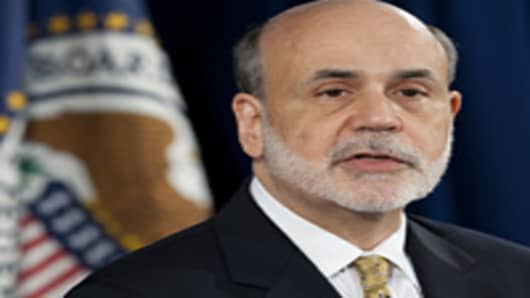Fed Chairman Ben Bernanke looks likely to leave the door open for further quantitative easing in his much-watched speech at the Kansas City Fed Conference in Jackson Hole Friday, but he is unlikely to give the market a definitive signal.
The trouble is that the economic data does not lend itself to obvious policy decisions. Growth of around 2 percent and payroll gains likely to be between 100,000 and 200,000 are an improvement over recent recession fears, but not strong enough to bring suggest a clear path of declining unemployment.
(Read More: Will Bernanke Give the Market What It Wants?)
"I think it's a close call, really," Atlanta Fed President Dennis Lockhart said in an interview with CNBC in Jackson. "If we were to see deterioration from this point, let's say a persistence of job growth numbers that were well below 100,000 a month, if we were to see signs of disinflation that could signal the onset of deflation, then there wouldn't be much of a question about policy. But now I think the policy question is how much will you gain and, of course, what are the costs — short and longer term." (Read More: More Fed Easing 'A Close Call': Fed's Lockhart.)
There is considerable data next week that could tip the balance for the Federal Open Market Committee. ISM indexes on the manufacturing and the services sector will give the first reads on the strength of the August economic bounceback. Fed Chairman Bernanke has made clear that job growth is a key indicator for Federal Reserve (learn more) policy so the August employment report coming Sept. 7 will weigh heavily in the decision.
(Read More: The Fed at Jackson Hole: Special Report.)
Until the situation clarifies, the Fed Chairman will probably try and get as much mileage as he can out of verbal intervention. This mostly involves keeping the possibility of further Fed action front and center for markets. It can work for a while, until the market no longer trades on the hints and nuances.
Part of the reason Bernanke is biding for time is that next week also will see a meeting of the European Central Bank (learn more), in which it is expected to offer the details of a plan to buy the sovereign debts of troubled countries that ask for assistance from the European rescue fund. Many observers believe the more the ECB does, the less the Fed will have to do. (Read More: Draghi to Germans: ECB Action Needed for Stability.)
So the key to listening to Bernanke's speech could be in how he characterizes the recent economic strength and how much he thinks additional Fed easing can help. He's already said publicly he thinks additional Fed easing can help the recovery but it's not clear how much a given amount of bond purchases can help the real economy and lower unemployment. Philadelphia Fed President Charles Plosser said in an interview that the costs of additional easing — which he's concerned can show up in inflation — outweigh the benefits. (Read More: Few Benefits of More Fed Easing: Fed's Plosser.)
It will also be important to watch discussions of alternative forms of easing in Bernanke's speech, such as communciations. The FOMC seemed to be close at its last meeting to lengthening the period during which it forecasts it will keep rates exceptionally low until 2015. There is also considerable discussion of scrapping calendar dates all together and perhaps pegging the period of low rates to hitting certain economic targets like unemployment, inflation and nominal gross domestic product.
Another reason not to expect a definitive announcement from Bernanke is that he has shown repeatedly that he does not want to front-run his commitee. While his opinion counts more than most, he has strived to let the final decision come from the committee. That's especially true in this time when the Fed is in the political spotlight and its policies are the subject of strong emotions on both sides. Bernanke would obviously prefer more committee support for another QE (learn more) move from both voters and non-voters on the committee.
There are strong feelings on both sides of the committee, with some Fed members saying explicitely that they've seen enough data already to know that the Fed needs to act. Others like Plosser think the Fed has done enough and the problems plaguing the economy aren't ones that can be fixed by monetary policy. Plosser pointed out that many Americans want to save more while Fed efforts to lower rates are designed to prompt Americans to borrow and spend more. So lower rates won't have much effect.
Still, it's likely that Bernanke has sufficient support now on the FOMC to push through additional QE if he wants to. And it's likely he will keep markets believing it's a real possibility. But the trigger won't be pulled until the September meeting.
—By CNBC's Steve Liesman
@steveliesman



